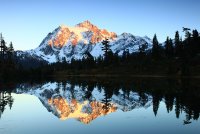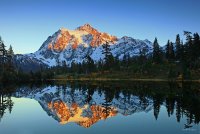is the first image a JPEG for comparison, or the original RAW file?
It was shot as a raw image. Here's the original raw file "1011001101010110010110100111100111011100011111001001100101001001010000100...(continues for a hundred pages or so)."

What you see above is a jpg rendered using the "Camera Neutral" setting in Lightroom which is reasonably close to what the camera would have produced had I been shooting jpegs. I suppose I could have opened it in CaptureNX to assure maximum fidelity to Nikon's rendering, but it's very close to the jpg preview, which the camera creates, so it's reasonably accurate.
That's part of the problem. People talk about "Straight out of camera". There is no such thing with a RAW file, at least not in the same way there was in film days, when certain films would have certain looks, such as "warmer" or "saturated". The RAW file's appearance will be influenced by which program you use to "develop" it. Unlike a JPG, which, in theory at least, should look the same in any image program, a RAW file is generated, on the fly, by the image processing software. Different programs will create different looks. RAW files are propietary, meaning they have a "secret sauce". Depending on how well the program you're using does at cracking the code, you may or may not see the same results in different programs. Some, such as Lightroom and Photoshop, allow you to choose "develop modes" which will also impact how the file looks. For example, on the Nikon side, "Camera Vivid" and "Camera Neutral" work pretty much exactly as the names imply they will.
Even when you shoot jpgs, and have the camera "develop" the image, you are still making choices regarding the image's contrast, saturation, sharpness etc. You can take two photos of an identical test scene with different camera settings and get different results.
The same is true of a RAW file. You can open in it different programs and it will look different. I can use CaptureNX (Nikon's program), CaptureOne or Lightroom/Photoshop and get three different results. (Why not four? Well, both LR and PS use Adobe Camera Raw for rendering, so
assuming you have the same settings, they should look the same.
It has gotten a lot better in recent years, but there was a time when Lightroom would wash out the reds in .nef (Nikon Raw) files. It was very disturbing, as it would show you the jpg preview for a moment as it rendered, then the image would blink and go dull. It was so bad that I took to batch processing the images in Capture NX, saving them as jpgs and using those instead. Thankfully I no longer need to do that.
The more you dig into this problem, the trickier it gets. Saturation, colors, white balance, sharpness, contrast. All can be adjusted when rendering the raw file. For that matter, so can exposure, at least to some degree. So you have to make choices for all of them. If you do not, and simply use "defaulit", you're still making a choice, you're simply choosing "Use the setting that the Nikon tech who designed this thought would work best in most situations..."




